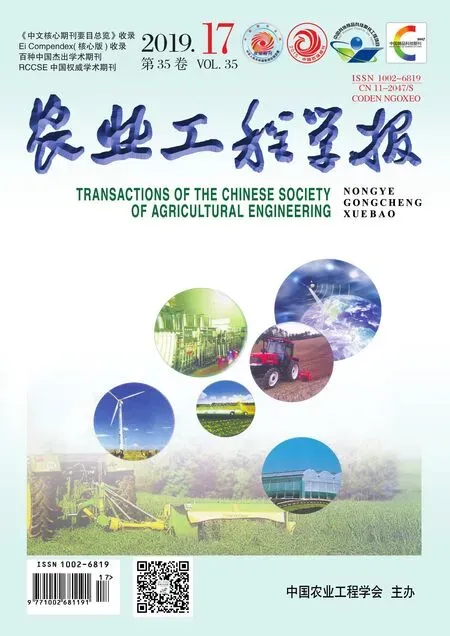寒区低能耗厌氧发酵反应器热工性能参数确定
刘建禹,邓斯文,杨胜明,管延萱
农业资源循环利用工程
寒区低能耗厌氧发酵反应器热工性能参数确定
刘建禹1,2,邓斯文1,杨胜明1,管延萱1
(1. 东北农业大学工程学院,哈尔滨 150030;2. 农业部生猪养殖设施工程重点实验室,哈尔滨 150030)
厌氧发酵反应器是沼气工程中的核心装置,研究寒区低能耗厌氧发酵反应器,不仅有助于降低沼气工程的能量损耗,提高耗能与产能的产出比,而且对大中型沼气工程在北方寒冷地区的推广与应用尤为重要。低能耗厌氧发酵反应器围绕的核心问题就是在保证反应器厌氧发酵功能的前提下,能的“量”和“质”合理有效利用程度。该文以建筑于地上全混合式厌氧发酵反应器为研究对象,采用能量分析和㶲分析方法,从反应器的体形、围护结构保温性能以及低㶲供热方式等方面对寒区低能耗厌氧发酵反应器节能特性进行了分析和研究,得到了低能耗厌氧发酵反应器最佳体形为高径比为1∶2的圆柱形;提出了哈尔滨、沈阳、北京地区在冬季室外计算温度下不同规模节能型反应器顶部、侧壁围护结构导热热阻的阈值;中温厌氧发酵反应器低㶲热水供热系统进出口温度分别为45和38 ℃,供热系统㶲效率为86%,反应器供能与用能间能级差为0.018,表明能级匹配合理,用能效率较高。该研究结论可为今后寒区低能耗厌氧发酵反应器的节能设计提供参考依据。
发酵;沼气工程;装置;厌氧发酵反应器;热能损耗;体形系数;保温;低㶲供热
0 引 言
利用有机废弃物进行厌氧发酵是集能源再生、环境保护、生态良性循环于一体的综合性技术。近年来随着能源短缺和环境污染及生态破坏程度的不断加剧,世界各国十分重视厌氧发酵技术的研究开发与利用,规模化大中型沼气工程正日益增多,且在运营成本和能源消耗方面也面临着重大挑战[1-6]。厌氧发酵反应器是沼气工程中的核心装置,微生物的繁殖、有机物的分解转化、沼气的生成都是在反应器内完成,控制反应器内稳定的发酵温度是沼气工程高效运行的重要保障[7]。在北方寒冷地区,由于冬季气候寒冷,室外气温远低于发酵温度,沼气工程的运行过程需要消耗大量的能源以补偿由温差造成的热能损耗,沼气工程的运行成本增大,能耗问题已成为制约沼气工程在北方寒冷地区发展的瓶颈[8]。厌氧发酵反应器的能耗是沼气工程运行过程中的主要能耗之一,研究低能耗厌氧发酵反应器,有助于降低沼气工程的能量损耗,提高耗能与产能的产出比,对大中型沼气工程在北方寒冷地区的推广与应用尤为重要。
低能耗厌氧发酵反应器围绕的核心问题就是在保证反应器厌氧发酵功能的前提下,反应器的合理有效的用能程度。从能的“量”和“质”的2个属性出发,实现反应器低能耗的主要途径有两方面:一是降低反应器围护结构传热耗热量。围护结构热工性能对于降低反应器能耗起到非常重要的作用,其中反应器的形状、尺寸及围护结构保温性能是影响反应器围护结构热工性能的主要因素,反应器热工设计合理,可有效降低反应器对供热系统的依赖。二是降低反应器供热系统的㶲损耗。反应器属于低品位热能用户,若使供热系统提供的热能得到合理利用,就必须根据用户需要,按质用能,不仅在数量上要满足,而且在质量上要匹配得当,从而达到节㶲的目的。目前,国内外对厌氧发酵反应器能耗的研究主要侧重于反应器传热模型的建立、反应器内物理量场的模拟、反应器能耗的预测以及反应器供热模式等方面[9-13],对反应器自身结构参数与热损失的关系、反应器供能与用能的能级匹配的研究甚少。在实际沼气工程中,对反应器的节能设计多依据经验数据,缺乏理论指导。为此,本研究以目前沼气工程常见的建筑于地上全混合式厌氧发酵反应器为例,运用能量分析和㶲分析的方法,并利用数学分析手段,从反应器的体形、围护结构保温性能以及低㶲供热方式等方面对如何降低反应器的能耗进行分析和研究,获取适用的设计参数,为今后低能耗反应器的设计提供理论依据。
1 厌氧发酵反应器体形系数与节能分析
厌氧发酵反应器体形的确定是反应器设计的核心内容。对于确定体积的全地上厌氧发酵反应器,反应器与外界大气接触的外表面积越小,其围护结构散热损失越低。为此,本研究借鉴建筑体形系数这一概念,通过分析计算获得适于北方寒冷地区沼气工程低能耗反应器结构设计参数。反应器体形系数定义为反应器与大气接触的外表面积与其所包围体积的比值,它反映了反应器外表面散热面积与体积的关系[14]。反应器体形系数越小,意味着反应器每单位体积与大气接触的面积越小,其传热耗热量也就越低。在保障反应器功能的前提下,减少反应器的体形系数是降低沼气工程加热能耗的有效措施之一。
1.1 反应器横截面对体形系数的影响
根据体形系数的定义,其数学表达式为

对于不同形状横截面的反应器,、存在不同的数量关系,为了便于分析横截面对反应器体形系数的影响,引入无量纲形状因子以表示二者间的关系[15],即

将式(2)代入式(1),可得

由式(3)可知,反应器的横截面积和高度一定时,体形系数随形状因子的减小而减小。利用式(2)计算得到不同形状横截面反应器的值,其结果见表1。

表1 不同截面形状因子对比
注:反应器的横截面积和高度一定,对于矩形截面,随着长宽比的增大,值增大。
Note: The cross-sectional area and height of the reactor are constant, for the rectangular section, the value ofincreases with the increase of aspect ratio.
从表1中的数据可以看出,当反应器的横截面积和高度确定后,横截面越接近圆形越小,当横截面为圆形时形状因子最小,即可保证反应器的体形系数最小,热能损失最低。从厌氧发酵技术角度看,横截面为圆形反应器有利于反应器内发酵料液搅拌均匀,消除死角,使厌氧微生物与有机物得到充分均匀地接触,提高厌氧微生物降解有机物的能力效率。因此,沼气工程中厌氧发酵反应器横截面宜采用圆形。
1.2 反应器体形系数的确定
本研究以常见的平顶型、锥顶型和拱顶型圆柱形反应器为对象(图1),探讨3种类型反应器体积一定时,体形系数的变化规律,并通过对比分析,得到适用于沼气工程的反应器最佳体形及参数,为实际沼气工程低能耗反应器结构设计提供理论依据。

注:h为反应器主体部分的高;h'为反应器顶部圆椎体或球切的高;D为反应器主体部分横截面直径;r为反应器主体部分横截面半径。
1.2.1 平顶型反应器




将式(6)代入式(5)

取反应器体积为定值,求解对的导数为

对的二阶导数为

1.2.2 锥顶型反应器
锥型反应器如图1b所示,其各体形参数之间关系如式(10)、(11)。

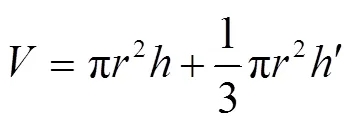
将式(10)、(11)代入式(1),可得



由于体积取常数,故为、的函数,式(13)变化为

将式(15)代入式(14)中,将化为、的函数
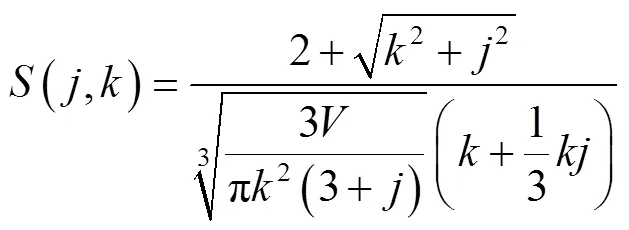
整理得

从式(17)可以看出,在反应器体积一定时,求解体形系数的最小值属于多元函数求极值问题。
对、的一阶偏导数为


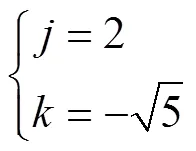

对、的二阶偏导数为

1.2.3 拱顶型反应器
拱型反应器如图1c所示,其各体形参数之间关系如式(21)、(22)。


将式(21)、(22)代入式(1),可得


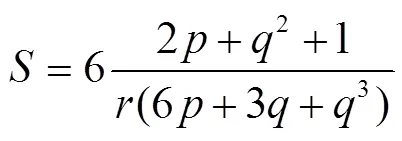
由于体积为常数,故为、的函数,式(24)变化为

将式(26)代入式(25)中,将化为、的函数


通过上述分析计算可以看出,对于体积相同的3种不同类型反应器的体形系数从小到大的依次顺序为:拱顶型反应器,锥顶型反应器,平顶型反应器。虽然拱顶型反应器的体形系数最小,散热损失最小,但根据拱顶反应器的廓形数、显示,其体形为一半球体;而锥顶型反应器廓形数显示其锥体部分过于高大,二者均不符合工程实际和工艺要求。因此,实际沼气工程宜采用尺寸为高度和半径比为1的平顶型圆柱反应器(具体设计参数可根据预设体积通过计算得到),不仅结构合理,且符合实际沼气工程工艺的需要。在实际反应器建设过程中,为了保证反应器顶部的强度,可适当起拱。

图2 拱顶型圆柱形厌氧发酵反应器体型系数模型
2 反应器围护结构热阻分析
反应器围护结构保温是提高反应器热工性能,降低沼气工程能耗的重要方法,保温层厚度的确定至关重要。保温层厚度越大,围护结构传热热阻越大,反应器的全年能耗越小,初投资增加;反之,保温层厚度越小,围护结构传热热阻越小,初投资减少,但运行费用增加。根据沼气工程实际情况,反应器体积相对较小,且保温材料成本较低廉,经过经济测算,运行成本远远高于一次性投入成本,故本文将从传热角度研究保温层厚度与反应器能耗的关系,确定反应器围护结构适宜的保温层厚度。考虑反应器规模及所处的地域差异,根据前述的研究成果,依据传热学原理,并通过数据分析手段对寒区典型城市:哈尔滨、沈阳、北京三地区体积为100、500、1 000、3 000 m3,高径比为1∶2的圆柱形厌氧发酵反应器的侧壁和顶部的保温层厚度进行分析研究。为初步确定传热模型中各参数值,以反应器材料为搪瓷钢板,保温材料采用密度为20 kg/m3的聚苯板,保护层材料为彩钢板(热阻忽略不计)为例进行研究。
2.1 反应器的侧壁和顶部传热模型
由于圆柱形反应器的高度远大于壁厚,因此可将反应器侧壁视为无限长圆筒壁,反应器侧壁传热量计算公式为[13]

式中为反应器的高度,m;t为料液温度,取35 ℃;t为冬季室外计算温度,采用历年平均不保证5 d的日平均温度[16],℃;h为反应器外表面传热系数,取23 W/(m2·K);d为反应器内径,m;δ为搪瓷钢板的厚度,取0.008 m;λ为搪瓷钢板的导热系数,由于搪瓷钢板搪瓷涂层仅0.3 mm,其导热系数按钢板导热系数计算,取36 W/(m·K);δ1为侧壁苯板的厚度,m;λ为苯板的导热系数,取0.041 W/(m·K)。
反应器顶部看作无限大平壁,反应器顶部传热量计算公式为

式中A为反应器顶部的面积,m2;δ2为顶部苯板的厚度,m;h为反应器内表面传热系数,取8.7 W/(m2·K)。
式(28)、(29)中各参数的取值来源于文献[1,17]。
2.2 保温层厚度的确定
根据不同体积的厌氧发酵反应器设计参数和不同地区室外气象资料,通过式(28)、(29)计算得到数值,绘制保温层厚度与反应器侧壁及顶部传热量之间的关系曲线,如图3所示。

a. 反应器侧壁
a. Side wall of reactor
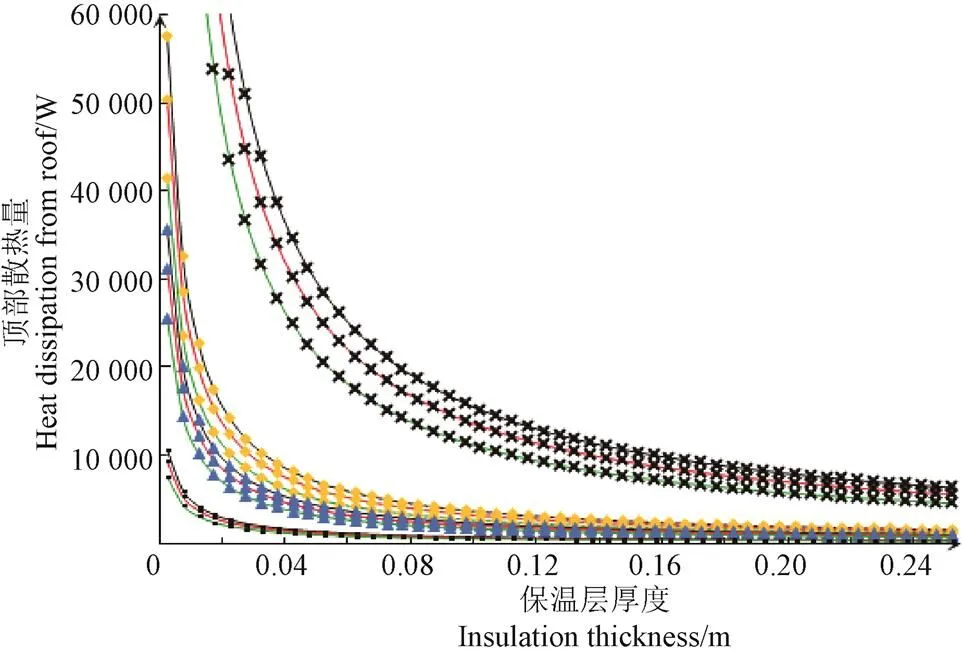
b. 反应器顶部
从上图中可以看出,当保温层增厚到一定程度时传热量已经没有明显下降的趋势,并逐渐趋于平稳。为此,选取保温层每0.005 m为一梯度,当保温层厚度增加到0.25~0.255 m区间时,传热量下降率已经低于0.05%,因此选定保温层厚度为0~0.25 m作为研究区间,确定保温层的厚度。但由于自变量保温层厚度与因变量反应器传热量两物理量数量级差异很大,若单纯对传热方程进行求导,得出的斜率值不能直观反映保温层厚度和反应器散热量两变量之间的关系趋势,没有指导性意义,因此将每一梯度的保温层厚度与其对应的反应器传热量进行无量纲化处理。
反应器侧壁传热量无量纲化公式[18]

反应器顶部传热量无量纲化公式[18]

保温层厚度无量纲化公式[18]

将原数据映射到0~1的数值范围内,该映射表征的是保温层厚度与反应器散热量之间的数值关系而非物理意义,通过映射数据绘制的曲线可替代原曲线表征反应器保温层厚度与散热量间关系。本研究设定当映射数据曲线斜率为0.1时认为曲线平稳并趋于一条直线,此时反应器各部分实际传热量下降率低于2%,说明此时散热量降低的空间已经相对微小,因此增加保温层厚度已经没有必要。各地区不同规模厌氧发酵反应器保温层厚度及导热热阻计算结果见表2。

表2 各地区不同规模沼气工程围护结构导热热阻及保温层
根据表2可以看出,各地区由于室外环境温度不同,所适用的保温层厚度及其对应的围护结构的导热热阻也不相同。但同一地区不同体积的厌氧发酵反应器保温层厚度无差异,可采用同一标准。
在实际工程中反应器材料和保温层材料会随地域、市价、气候等诸多因素的变化进行调整。当采用其他类型反应器材料如:钢筋混凝土、利浦罐、搪瓷拼装罐;保温材料如:泡沫珍珠岩、聚氨酯等时,保温材料厚度可根据表2中给出的围护结构导热热阻进行换算。
反应器顶部

反应器侧壁

3 反应器低㶲供热系统能效分析



该对数平均温差可以广泛用于对不同体积反应器的盘管式换热器进行设计计算。
3.1 换热器㶲效率分析

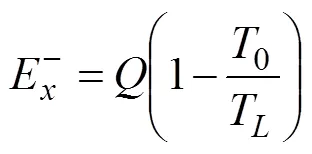


根据式(38)、(39)可求得换热器的㶲效率为[22,27]
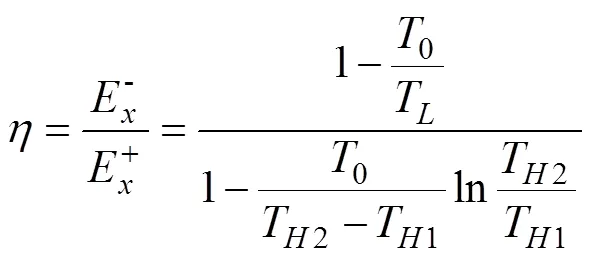
3.2 换热器的能级分析
换热器的能级指热媒的能量中㶲所占的比例,热水供给热量的能级系数为[29-32]

反应器耗热量的能级系数为

换热器能量供需间能级差为

在能量有效利用过程中,㶲效率越高,能级差越小说明能量合理利用的完整程度越好。通过以上计算结果可以得出,厌氧发酵反应器利用低温热源供热,由传热温差造成的不可逆过程能量损失较少,能量的价值得到充分的利用,供热与用能双方在能量品质上匹配合理,从而达到科学用能的目的。
4 结 论
本文以建筑于地上全混合式厌氧发酵反应器为例,从反应器的体形、围护结构保温性能以及低㶲供热方式3个方面对寒区低能耗厌氧发酵反应器节能特性进行了分析和研究,得到结论如下:
1)引入建筑体型系数,建立寒区沼气工程中3种典型厌氧发酵反应器的体型系数模型。在体型系数最小化的约束条件下,拱顶型和锥顶型反应器的廓形数与发酵工艺要求不符,因此确定实际工程中高径比为1∶2的平顶型反应器最为节能。
2)建立了高径比为1∶2圆柱形厌氧发酵反应器顶部及侧壁的传热模型,得出了哈尔滨地区、沈阳地区、北京地区在冬季室外计算温度下不同规模节能型反应器顶部和侧壁围护结构导热热阻的限值,各类型材料的反应器或保温层均可依据该限值进行折算设计。
3)通过对厌氧发酵反应器供热系统㶲分析,确定了换热器热水进口温度为45 ℃,出口温度为38 ℃,该温差下㶲效率为86%,反应器供能与用能间能级差为0.018,表明能级匹配合理,用能效率较高。
[1] 刘建禹,贺佳贝,杨胜明,等. 寒区沼气工程地下水源热泵加热系统能效分析[J]. 农业工程学报,2018,34(5):191-195. Liu Jianyu, He Jiabei, Yang Shengming, et al. Energy efficiency analysis of groundwater source heat pump heating system in cold area biogas project[J]. Transactions of the Chinese Society of Agricultural Engineering(Transactions of the CSAE), 2018, 34(5): 191-195. (in Chinese with English abstract)
[2] Awe O W, Zhao Y, Nzihou A, et al. A review of biogas utilisation, purification and upgrading technologies[J]. Waste and Biomass Valorization, 2017, 8(2): 267-283.
[3] Ginting N. Benefits of using biogas technology in rural area: Karo district on supporting local action plan for greenhouse gas emission reduction of north sumatera province 2010–2020[J]. IOP Conference Series: Earth and Environmental Science, 2017, 65(1) :1-6.
[4] Chen L, Cong R G, Shu B, et al. A sustainable biogas model in China: The case study of Beijing Deqingyuan biogas project[J]. Renewable & Sustainable Energy Reviews, 2017, 78: 773-779.
[5] Asai M, Hayashi T, Yamamoto M. Mental model analysis of biogas energy perceptions and policy reveals potential constraints in a Japanese farm community[J]. Sustainability, 2019, 11(1):225-245.
[6] 刘建禹,李文涛,陈泽兴,等. 基于地下水源热泵的寒区沼气工程加热模式的探讨[J]. 农业工程学报,2013,29(5):163-169. Liu Jianyu, Li Wentao, Chen Zexing, et al. Heating mode of biogas plant in alpine region based on underground water source heat pump[J]. Transactions of the Chinese Society of Agricultural Engineering (Transactions of the CSAE), 2013, 29(5): 163-169. (in Chinese with English abstract)
[7] 刘建禹,樊美婷,刘科. 高寒地区沼气发酵料液加热增温装置传热特性[J]. 农业工程学报,2011,27(2):298-301. Liu Jianyu, Fan Meiting, Liu Ke. Heat transfer characteristics of warming methane fermentation liquid heating device in alpine region[J]. Transactions of the Chinese Society of Agricultural Engineering (Transactions of the CSAE), 2011, 27(2): 298-301. (in Chinese with English abstract)
[8] Costa J C , Moita I , Abreu A A , et al. Advanced monitoring of high-rate anaerobic reactors through quantitative image analysis of granular sludge and multivariate statistical analysis[J]. Biotechnology and Bioengineering, 2009, 102(2):445-456.
[9] 王荣光, 沈天行. 可再生能源利用与建筑节能[M]. 北京:机械工业出版社, 2004.
[10] Knauer T, Scholwin F, Nelles M. Maximizing the energy output from biogas plants: Optimisation of the thermal consumption of biogas systems[J]. Waste & Biomass Valorization, 2018, 9(1): 1-11.
[11] 王丽丽,杨印生,王忠江. 北方大型沼气工程加热保温系统优化[J]. 吉林大学学报:工学版,2011,41(4):1183-1188. Wang Lili, Yang Yinsheng, Wang Zhongjiang. Optimization on heating and insulating system for northern large-scale biogas project[J]. Journal of Jilin University:Engineering and Technology Edition, 2011, 41(4): 1183-1188. (in Chinese with English abstract)
[12] Gérard Merlin, Fran ois Kohler. Importance of heat transfer in an anaerobic digestion plant in a continental climate context[J]. Bioresource Technology, 2012, 124: 59-67.
[13] 刘建禹,陈泽兴,李文涛. 厌氧发酵反应器一维稳态传热模型的建立与验证[J]. 农业工程学报,2012,28(17):217-222. Liu Jianyu, Chen Zexing, Li Wentao. Development and verification of one-dimensional model of steady-state heat transfer for anaerobic fermentation reactor[J]. Ransactions of the Chinese Society of Agricultural Engineering (Transactions of the CSAE), 2012, 28(17): 217-222. (in Chinese with English abstract)
[14] 中华人民共和国住房和城乡建设部. 严寒和寒冷地区居住建筑节能设计标准: JGJ26-2010 [S],北京:中国建筑工业出版社,2010.
[15] 刘仙萍,丁力行. 建筑体形系数对节能效果的影响分析[J]. 湖南科技大学学报:自然科学版,2006,21(2):25-28. Liu Xianping, Ding Lixing. Analysis on the effect of building shape coefficient for energy saving[J]. Journal of Hunan University of Science & Technology: Natural Science Edition, 2006, 21(2): 25-28. (in Chinese with English abstract)
[16] 中华人民共和国住房和城乡建设部. 民用建筑供暖通风与空气调节设计规:GB 50736-2012 [S]. 北京:中国建筑工业出版社,2010.
[17] 陈泽兴,刘建禹,李文涛. 寒区沼气发酵地源热泵增温系统的初步研究[J]. 农机化研究,2011,33(3):219-222. Chen Zexing, Liu Jianyu, Li Wentao. Preliminary study of operation parameters for ground heat pump heating system of biogas fermentation in alpine region[J]. Journal of Agricultural Mechanization Research, 2011, 33(3): 219-222. (in Chinese with English abstract)
[18] 洪松林,庄映辉,李堃著. 数据挖掘与工程实践[M]. 机械工业出版社,2014.
[19] 项新耀著. 工程㶲分析方法[M]. 石油工业出版社,1990.
[20] 马溪平. 厌氧微生物学与污水处理[M]. 北京:化学工业出版社,2005.
[21] 刘建禹,杨胜明,贺佳贝,等. 寒区沼气工程热能损耗分布规律及节能途径探讨[J]. 农业工程学报,2018,34(22):220-227. Liu Jianyu, Yang Shengming, He Jiabei, et al. Thermal energy loss distribution and energy saving ways of biogas engineering in cold regions[J]. Transactions of the Chinese Society of Agricultural Engineering (Transactions of the CSAE), 2018, 34(22): 220-227. (in Chinese with English abstract)
[22] 吴存真,张诗针,孙志坚. 热力过程㶲分析基础[M]. 杭州:浙江大学出版社,1999.
[23] Lei F, Hu Pngfang. Energy and exergy analysis of a ground water heat pump system[J]. Fluid Machinery, 2012, 24(2): 169-175.
[24] 张永贵. 热泵定义的拓展及其㶲效率表达式的改进[J]. 暖通空调,2002,32(1):99-100. Zhang Yonggui. To improve the development of heat pump and exergy efficiency definition expression[J]. HVAC, 2002, 32(1): 99-100. (in Chinese with English abstract)
[25] 胡亚范,谈宏莹,张永贵. 热泵供热系统的㶲评价方法[J]. 建筑科学,2009,25(10):45-48. Hu Yafan, Tan Hongying, Zhang Yonggui. The exergy evaluation method of heat pump heating system[J]. Architecture Science, 2009, 25(10): 45-48. (in Chinese with English abstract)
[26] 张永贵,胡亚范,王厚才. 热泵定义及㶲效率计算方法探讨[J]. 节能与环保,2001, 10(2): 16-18. Zhang Yonggui, Hu Yafan, Wang Houcai. Definition of heat pump and calculation method of exergy efficiency[J]. Energy Saving and Environmental Protection, 2001, 10(2): 16-18. (in Chinese with English abstract)
[27] 朱培根. 热泵空调器节能㶲分析及优化[J]. 低温工程,2000,5(11):54-59. Zhu Peigen. Exergy analysis and optimization of energy saving of heat pump air conditioner[J]. Cryogenic Engineering, 2000, 5(11): 54-59. (in Chinese with English abstract)
[28] 潘勇. 㶲分析环境模型及其确立原则的研究[J]. 煤炭与化工,2007,30(6):18-20. Pan Yong. Study on exergy analysis of environment model and establish the principle[J]. Coal and Chemical Industry, 2007, 30(6): 18-20. (in Chinese with English abstract)
[29] Rijs A, Mróz T. Exergy evaluation of a heat supply system with vapor compression heat pumps[J]. Energies, 2019, 12(6):1028-1047.
[30] 杨东华. 㶲分析和能级分析[M]. 北京:科学出版社,1986.
[31] 周燕. 建筑供暖与制冷能量系统(㶲)分析及应用研究[D]. 长沙:湖南大学, 2013. Zhou Yan. Building Heating and Cooling Energy System Exergy Analysis and Application Research[D]. Changsha: Hunan University, 2013. (in Chinese with English abstract)
[32] 艾亨J E. 能量系统的㶲分析方法[M]. 北京:北京机械工业出版社,1984.
Determination of thermal performance parameters of low-energy anaerobic fermentation reactor in cold region
Liu Jianyu1,2, Deng Siwen1, Yang Shengming1, Guan Yanxuan1
(1.,,150030,;2.,,150030,)
Anaerobic fermentation reactor is the core device of biogas projects. The study of low-energy anaerobic fermentation reactor in cold region is not only helpful to reduce the energy loss of biogas projects and to improve the output ratio of energy consumption and productivity, but also particularly important for the promotion and application of large and medium-sized biogas projects in cold northern China. The key issue about the low-energy anaerobic fermentation reactor is how to reasonably and effectively utilize “quantity” and “quality” of energy under the premise of ensuring the function of the reactor. In this paper the full hybrid anaerobic fermentation reactor built on the ground is taken as the research object. According to the method of energy analysis and exergy analysis, the author analyzes the energy-saving characteristics of low-energy anaerobic fermentation reactor in cold region in terms of the geometry analysis and the performance of envelope thermal insulation and the heating method of low-exergy. In this paper, the key problem of anaerobic fermentation reactor design is solved by using the concept of building shape coefficient. First, the shape of the reactor cross section is determined and 3 types of the reactor body shape coefficient models are established and solved by numerical analysis. The calculation results show that the optimal shape of the low-energy anaerobic fermentation reactor is cylindrical, and the aspect ratio is 1:2. Second, based on heat transfer theory, the thermal conductivity models of the difference of the volume of the reactor envelope structure are established by statistical method and numerical analysis. The results show that the limits of thermal resistance of heat conduction of the top and side wall envelopes of the energy-saving reactors in Harbin, Shenyang and Beijing under the outdoor temperature in winter were determined. When using other types of reactor materials, such as reinforced concrete, lipo tank, enamel assembly tank, and the insulation materials such as: foam perlite, polyurethane, etc, the thickness of insulation material can be converted according to the heat conduction and thermal resistance of the enclosure structure. Third, according to the method of exergy analysis, the heating system of medium temperature anaerobic fermentation reactor is analyzed and level analysis is used. Exergic losses caused by irreversible process should be reduced as much as possible. The calculation results determine that the inlet and outlet temperatures of the thermal medium of heating system are 45 and 38 ℃respectively, and the heating system efficiency is 86%, and the logarithmic mean temperature difference is 5.8 ℃. The model calculation results showed that the energy level difference between the energy supply and the energy consumption of the reactor is 0.018, which indicates that the energy levels can be matched and energy can be used efficiently. The conclusion can be used as a reference for energy saving design of low energy consumption anaerobic fermentation reactor in cold region.
fermentation; biogas project; equipment; anaerobic fermentation reactor; heating consumption; shape coefficient; heat preservation; low-exergy heating
2019-05-10
2019-08-16
黑龙江省科技攻关项目,寒区厌氧发酵地源热增温技术的研究(GA09B503-1)
刘建禹,教授,主要从事农业生物环境与能源工程的教学和科研工作。Email:dengsiwen427@163.com。
10.11975/j.issn.1002-6819.2019.17.030
S216.4
A
1002-6819(2019)-17-0248-08
刘建禹,邓斯文,杨胜明,管延萱. 寒区低能耗厌氧发酵反应器热工性能参数确定[J]. 农业工程学报,2019,35(17):248-255. doi:10.11975/j.issn.1002-6819.2019.17.030 http://www.tcsae.org
Liu Jianyu, Deng Siwen, Yang Shengming, Guan Yanxuan. Determination of thermal performance parameters of low-energy anaerobic fermentation reactor in cold region[J].Transactions of the Chinese Society of Agricultural Engineering (Transactions of the CSAE), 2019, 35(17): 248-255. (in Chinese with English abstract) doi:10.11975/j.issn.1002-6819.2019.17.030 http://www.tcsae.org

